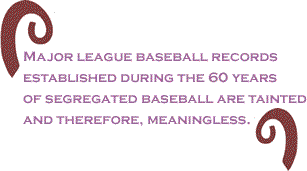
On a sunny July day in 1887,
Cap Anson of the Chicago White Stockings refused to play a
team from Newark unless they
removed their starting pitcher, an African American named George
Stovey. Thus began the 60 year reign of apartheid baseball in
America. The present day media fuss over steroid use
in major league baseball is reaching pandemic proportions. At a time in American history
of pre-emptive wars, unchecked corporate looting, increasing poverty
and homelessness, continuing assaults on the Bill of Rights...but
STOP THE PRESSES! A baseball player may be using performance enhancing
drugs!
Based on Grand Jury leaks of player testimony
(hmmm, this technique looks familiar), congressional blowhards
from the major parties
have been falling over themselves to get to a media outlet and
express their outrage over this heinous situation. Even George
Bush, that paragon of honesty and hard work, has weighed in on
the matter, stating on two separate occasions that steroid use “diminishes
the integrity of sports” and “sends the wrong message that there
are shortcuts to accomplishments.”
Sports fans – always eager to turn on their heroes
at the first signs of fallibility – are clamoring for changing
the records of suspected steroid users or adding asterisks on the
player’s record,
ala the asterisk placed on Roger Maris’ numbers when he broke Babe
Ruth’s single season homerun record in 1961. (The season was
eight games shorter in Ruth’s time.)

Baseball is obsessed with statistics and records – and the “purity” of
those records – even though controversies have risen over the ever-changing
height of the pitcher’s mound,  the introduction of the “juiced” ball,
the short left fields of the old “bandbox” stadiums, etc. Through
it all, the stats remain the Holy Grail of Major League Baseball.
Woe betide anyone who messes with the Sacred Records. the introduction of the “juiced” ball,
the short left fields of the old “bandbox” stadiums, etc. Through
it all, the stats remain the Holy Grail of Major League Baseball.
Woe betide anyone who messes with the Sacred Records.
And yet, oddly enough, there was no hue and
cry in 1998 when Mark McGuire, blown up like the Pillsbury doughboy from ingesting tablespoons
of something other than applesauce, broke Roger Maris’ homerun
record. McGuire admitted that he was taking androstenedione, a
substance banned by the Olympic Committee, the National Football
League and the National Collegiate Athletic Association. He didn’t
stop taking it until the following season.
No fuss. No outrage. No talk show blather. No senators screaming
into the television cameras about the morality of athletes and
sanctity of records. McGuire is white.
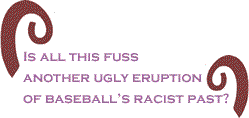
The current target of wrath over suspected
substance abuse is Barry Bonds, a home run hitter who will probably
break the immortal
Babe Ruth’s record during the coming season. Bonds is an African
American. Is all this fuss another ugly eruption of baseball’s
racist past?
 In the 20th Century, baseball was
America’s Favorite
Past Time, second only to invading small countries. Baseball players
and their records were cultural icons; every kid knew the batting
averages and rbi’s of their favorite players. How many wins? How
many hits in a season? How many homeruns? What did DiMaggio do
today? When Ruth was asked why he was paid more than the Depression-plagued
President, he responded “because I had a better year.” In the 20th Century, baseball was
America’s Favorite
Past Time, second only to invading small countries. Baseball players
and their records were cultural icons; every kid knew the batting
averages and rbi’s of their favorite players. How many wins? How
many hits in a season? How many homeruns? What did DiMaggio do
today? When Ruth was asked why he was paid more than the Depression-plagued
President, he responded “because I had a better year.”
How would these records have changed if African
Americans (and Latinos of African ancestry) had been included
during the 60 year
period of color line baseball? What impact would black players
have had on the records of the all-white baseball players? Would
Ruth have still hit 714 homeruns if he had to face pitchers like
Satchel Paige, Leon Day or Smokey Joe Williams? It seems unlikely.
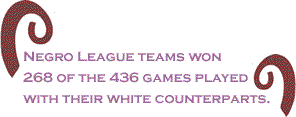
Banned from Major League Baseball, black athletes
played professional baseball in the Negro Leagues, which lasted
until baseball integration
in the late 1940’s. However, for over thirty years during the
off season, Negro League teams played exhibition games against
teams of white major league all stars. The pre eminent baseball
historian, John Holway, has determined that Negro League teams
won 268 of the 436 games played with their white counterparts.
That’s a .615 winning percentage! Baseball is a game in which
a .300 hitter is regarded as a huge success. In competition, the
white players were blown away by the black 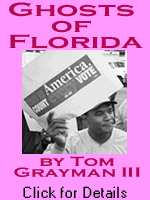 players. For example,
Smokey Joe Williams struck out 20 white New York Giants during
a 1914 game. Williams was 26-5 against the white major league
teams. Ty Cobb was major league baseball’s base-stealing champion,
but he was thrown out trying to steal three times in one exhibition
game by a Negro League catcher, Bruce Petway. Negro League pitcher
Webster McDonald was 14-2 against white major leaguers. players. For example,
Smokey Joe Williams struck out 20 white New York Giants during
a 1914 game. Williams was 26-5 against the white major league
teams. Ty Cobb was major league baseball’s base-stealing champion,
but he was thrown out trying to steal three times in one exhibition
game by a Negro League catcher, Bruce Petway. Negro League pitcher
Webster McDonald was 14-2 against white major leaguers.
Phenomenal records were established in the
caliber of play within the Negro League itself. Pitcher Leon Day had a .708 winning percentage,
Ray Brown was .747. Josh Gibson hit a 580 foot homerun at Yankee
Stadium during a Negro League game.
When Satchel Paige, perhaps the most famous
of the Negro League pitchers, was finally allowed into Major
League Baseball he was
well over 40 years old. However, in his first season his ERA was
2.48 and his fast ball was clocked at 103 mph!
White major league players knew how good the
African American players were during that era and also knew that
many of them would
lose their jobs to superior players if the color barrier was lifted. After
all, they played against them off season on a regular basis for
many years. Some white players were quite candid in their assessment
of the skills of the Negro League players.
Hall of Fame pitcher Walter “Big Train” Johnson testified that
Josh Gibson “hits the ball a mile and he catches so easy he might
as well be in a rocking chair. Throws like a rifle. Too bad this
Gibson is a colored fellow.”
Batting champion and hitting maestro Ted Williams
called Satchel Paige “the best pitcher in baseball.” Baseball icon Joe DiMaggio
concurred, stating that Paige was “the best pitcher I ever faced
and the fastest.”
Paige was an old man when he faced down premiere
hitters like Williams and DiMaggio in the 1940’s. If he had been allowed into
the white man’s league 20 years earlier, how would Ruth and Lou
Gehrig and Al Simmons have fared against Paige and his 100mph plus
fast ball?
Josh Gibson hit over 900 home runs in the Negro
League, including majestic shots in major league parks like Yankee
Stadium and Forbes
Field. The odds are that – facing the same pitching as Ruth (with
all the white stiffs who pitched all 9 innings) – Gibson would
have surpassed Ruth in home runs. In 2005, Barry Bonds would be
going after Josh Gibson’s record, not Ruth’s.
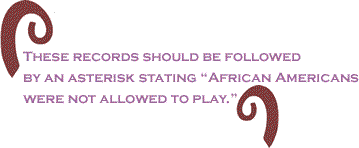
Simply stated, major league baseball records established during
the 60 years of segregated baseball are tainted and therefore,
meaningless.
These records were established during a period
in which many of the best players of the game were excluded from
the game. The
white players knew it. The white owners knew it. A reasonable
observer must conclude that these records should be followed by
an asterisk stating “African Americans were not allowed to play.”
Back to that incident in 1887: Was Cap Anson just a vile racist
or was he worried about protecting his batting average? Anson
was a ham-fisted fielder who holds the all-time record for most
errors committed by a first baseman. His Hall of Fame credentials
were built on his hitting. Did Anson really want to face a pitcher
like George Stovey who in 1886 held opposing hitters to .167 and
went 34-14 in 1887?
End of story: Anson and the white major leaguers who followed
him knew that their records would be shredded by the black athletes,
jeopardizing not only their jobs, but also their stature as American
cultural icons in sports pages, baseball cards and movies.
Don Santina is a cultural historian who has written on film
history, music and sports. His articles have appeared
in the People’s Weekly World, Counterpunch, the Black Commentator,
and the San Francisco Chronicle. His monograph on the Cisco
Kid legend in film is in the archives of the Motion Picture Academy. |






